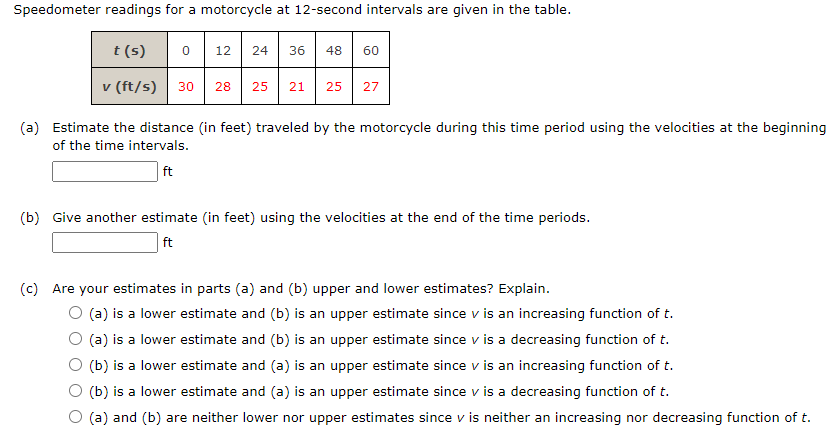Speedometer readings for a motorcycle at 12-second intervals are given in the table. t (s) 12 24 36 48 60 v (ft/s) 30 28 25 21 25 27 (a) Estimate the distance (in feet) traveled by the motorcycle during this time period using the velocities at the beginning of the time intervals. ft (b) Give another estimate (in feet) using the velocities at the end of the time periods. ft (c) Are your estimates in parts (a) and (b) upper and lower estimates? Explain. (a) is a lower estimate and (b) is an upper estimate since v is an increasing function of t. O (a) is a lower estimate and (b) is an upper estimate since v is a decreasing function of t. (b) is a lower estimate and (a) is an upper estimate since v is an increasing function of t. (b) is a lower estimate and (a) is an upper estimate since v is a decreasing function of t. (a) and (b) are neither lower nor upper estimates since v is neither an increasing nor decreasing function of t.
Speedometer readings for a motorcycle at 12-second intervals are given in the table. t (s) 12 24 36 48 60 v (ft/s) 30 28 25 21 25 27 (a) Estimate the distance (in feet) traveled by the motorcycle during this time period using the velocities at the beginning of the time intervals. ft (b) Give another estimate (in feet) using the velocities at the end of the time periods. ft (c) Are your estimates in parts (a) and (b) upper and lower estimates? Explain. (a) is a lower estimate and (b) is an upper estimate since v is an increasing function of t. O (a) is a lower estimate and (b) is an upper estimate since v is a decreasing function of t. (b) is a lower estimate and (a) is an upper estimate since v is an increasing function of t. (b) is a lower estimate and (a) is an upper estimate since v is a decreasing function of t. (a) and (b) are neither lower nor upper estimates since v is neither an increasing nor decreasing function of t.
Chapter6: Exponential And Logarithmic Functions
Section6.1: Exponential Functions
Problem 60SE: The formula for the amount A in an investmentaccount with a nominal interest rate r at any timet is...
Related questions
Question
100%

Transcribed Image Text:Speedometer readings for a motorcycle at 12-second intervals are given in the table.
t (s)
12
24
36
48
60
v (ft/s)
30
28
25
21
25
27
(a) Estimate the distance (in feet) traveled by the motorcycle during this time period using the velocities at the beginning
of the time intervals.
ft
(b) Give another estimate (in feet) using the velocities at the end of the time periods.
ft
(c) Are your estimates in parts (a) and (b) upper and lower estimates? Explain.
(a) is a lower estimate and (b) is an upper estimate since v is an increasing function of t.
O (a) is a lower estimate and (b) is an upper estimate since v is a decreasing function of t.
(b) is a lower estimate and (a) is an upper estimate since v is an increasing function of t.
(b) is a lower estimate and (a) is an upper estimate since v is a decreasing function of t.
(a) and (b) are neither lower nor upper estimates since v is neither an increasing nor decreasing function of t.
Expert Solution
This question has been solved!
Explore an expertly crafted, step-by-step solution for a thorough understanding of key concepts.
This is a popular solution!
Trending now
This is a popular solution!
Step by step
Solved in 2 steps with 2 images

Recommended textbooks for you


Trigonometry (MindTap Course List)
Trigonometry
ISBN:
9781337278461
Author:
Ron Larson
Publisher:
Cengage Learning

Big Ideas Math A Bridge To Success Algebra 1: Stu…
Algebra
ISBN:
9781680331141
Author:
HOUGHTON MIFFLIN HARCOURT
Publisher:
Houghton Mifflin Harcourt


Trigonometry (MindTap Course List)
Trigonometry
ISBN:
9781337278461
Author:
Ron Larson
Publisher:
Cengage Learning

Big Ideas Math A Bridge To Success Algebra 1: Stu…
Algebra
ISBN:
9781680331141
Author:
HOUGHTON MIFFLIN HARCOURT
Publisher:
Houghton Mifflin Harcourt

College Algebra
Algebra
ISBN:
9781305115545
Author:
James Stewart, Lothar Redlin, Saleem Watson
Publisher:
Cengage Learning

Algebra & Trigonometry with Analytic Geometry
Algebra
ISBN:
9781133382119
Author:
Swokowski
Publisher:
Cengage